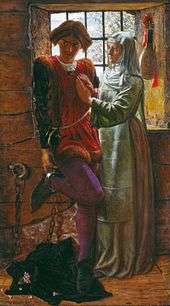Bletting
Bletting is a process of softening that certain fleshy fruits undergo, beyond ripening. There are some fruits that are either sweeter after some bletting, such as sea buckthorn, or for which most varieties can be eaten raw only after bletting, such as medlars, persimmons, quince, service tree fruit, and wild service tree fruit ("chequers"). The rowan or mountain ash fruit must be bletted and cooked to be edible, to break down the toxic parasorbic acid (hexenollactone) into sorbic acid.
Process

Ripe medlars, for example, are taken from the tree, placed somewhere cool, and allowed to ripen for several weeks. In Trees and Shrubs, horticulturist F. A. Bush wrote about medlars that "if the fruit is wanted it should be left on the tree until late October and stored until it appears in the first stages of decay; then it is ready for eating. More often the fruit is used for making jelly." Ideally, the fruit should be harvested from the tree immediately following a hard frost, which starts the bletting process by breaking down cell walls and speeding softening.
Chemically speaking, bletting brings about an increase in sugars and a decrease in the acids and tannins that cause the unripe fruit to be astringent.[1][2]
Once the process is complete, the medlar flesh will have broken down enough that it can be spooned out of the skin. The taste of the sticky, mushy substance has been compared to sweet dates and dry applesauce, with a hint of cinnamon. In Notes on a Cellar-Book, the great English oenophile George Saintsbury called bletted medlars the "ideal fruit to accompany wine."
History
The English verb to blet was coined by John Lindley, in his Introduction to Botany (1835). He derived it from the French poire blette meaning 'overripe pear'. "After the period of ripeness," he wrote, "most fleshy fruits undergo a new kind of alteration; their flesh either rots or blets."[3]
In Shakespeare's Measure for Measure, he alluded to bletting when he wrote (IV. iii. 167) "They would have married me to the rotten Medler." Thomas Dekker also draws a saucy comparison in his play The Honest Whore: "I scarce know her, for the beauty of her cheek hath, like the moon, suffered strange eclipses since I beheld it: women are like medlars – no sooner ripe but rotten." Elsewhere in literature, D. H. Lawrence dubbed medlars "wineskins of brown morbidity."
There is also an old saying, used in Don Quixote, that "time and straw make the medlars ripe," referring to the bletting process.
See also
| Wikibooks Cookbook has a recipe/module on |
- Climacteric, the final stage of fruit ripening in many, but not all fruits
- Date Palm, whose tamr (ripe, sun-dried) stage is similar to bletting
- Fermentation (biochemistry)
- Fermentation (food)
- Industrial fermentation
- Icewine
References
- ↑ Glew, R.H.; Ayaz, F.A.; Sanz, C.; VanderJagt, D.J.; Huang, H.S.; Chuang, L.T.; Strnad, M. (2003). "Changes in sugars, organic acids and amino acids in medlar (Mespilus germanica L.) during fruit development and maturation". Food Chemistry. 83 (3): 363–369. doi:10.1016/s0308-8146(03)00097-9.
- ↑ Rop, O.; Sochor, J.; Jurikova, T.; Zitka, O.; Skutkova, H.; Mlcek, J.; Salas, P.; Krska, B.; Babula, P.; Adam, V.; Kramarova, D.; Beklova, M.; Provaznik, I.; Kizek, R. (2011). "Effect of Five Different Stages of Ripening on Chemical Compounds in Medlar (Mespilus germanica L.)". Molecules. 16 (74-91). doi:10.3390/molecules16010074.
- ↑ John Lindley 1835. Introduction to Botany, p. 296
